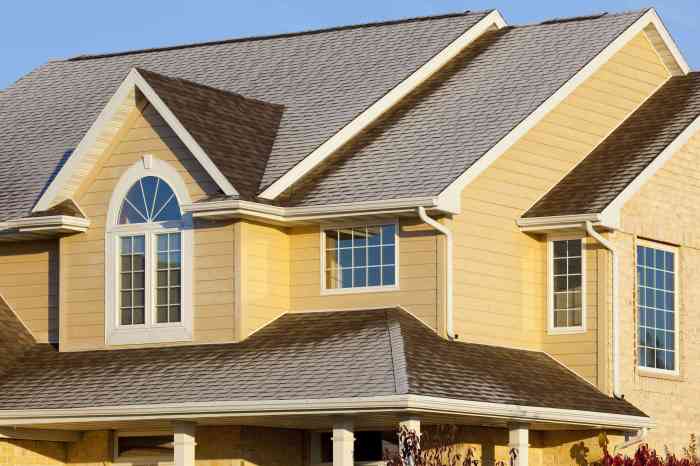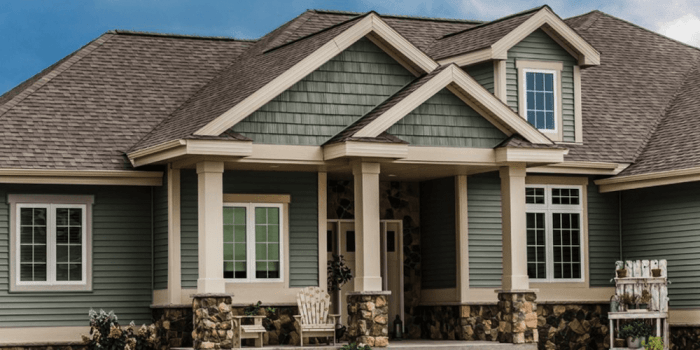Exploring the world of siding options for homes can be a daunting task, but fear not! In this detailed guide, we delve into the realm of the best siding for homes, providing you with valuable insights and comparisons to help you make the right choice for your abode.
As we navigate through the various types of siding materials, factors to consider, cost comparisons, and the impact of aesthetics and design, you'll gain a deeper understanding of what sets each option apart and which one might be the perfect fit for your home.
Types of Siding Materials
When it comes to choosing siding materials for your home, there are several options available, each with its own set of pros and cons. It's important to consider factors such as durability, maintenance requirements, and overall aesthetic appeal before making a decision.
Vinyl Siding
Vinyl siding is a popular choice among homeowners due to its affordability and low maintenance requirements. It is available in a wide range of colors and styles, making it versatile for different home designs. However, vinyl siding may crack or fade over time, and it is not as durable as some other materials.
Fiber Cement Siding
Fiber cement siding is known for its durability and resistance to rot, insects, and fire. It can mimic the look of wood or stucco without the high maintenance requirements. However, fiber cement siding is heavier and may require professional installation.
Wood Siding
Wood siding offers a natural and timeless look that many homeowners love. Cedar and redwood are popular choices for wood siding due to their durability and resistance to decay. However, wood siding requires regular maintenance, such as painting or staining, to prevent rot and insect damage.
Aluminum Siding
Aluminum siding is lightweight, easy to install, and resistant to fire and insects. It is also a low-maintenance option that can last for many years. However, aluminum siding may dent easily and may not offer as much insulation as other materials.
Brick Siding
Brick siding is highly durable and requires minimal maintenance. It offers excellent insulation properties and can last for decades without needing to be replaced. However, brick siding is one of the more expensive options and may require professional installation.
Stucco Siding
Stucco siding is a durable and low-maintenance option that can withstand various weather conditions. It offers a unique texture and appearance that can enhance the curb appeal of a home. However, stucco siding may crack over time and can be costly to repair.
Factors to Consider
When choosing siding for your home, there are several important factors to consider to ensure you make the right choice. One of the key factors is the climate and location of your home, as these play a significant role in the durability and effectiveness of the siding material.
Different materials perform better in certain climates, so it's essential to select one that can withstand the weather conditions in your area.
Impact of Climate and Location
Climate and location have a significant impact on the choice of siding material for your home. For instance, vinyl siding is a popular choice in areas with moderate climates, as it is durable and low maintenance. On the other hand, fiber cement siding is more suitable for areas with extreme weather conditions, such as heavy rain or strong winds.
Importance of Energy Efficiency
Energy efficiency is another crucial factor to consider when selecting siding for your home. Insulated siding options can help improve the energy efficiency of your home by reducing heat loss during the winter and heat gain during the summer. This can lead to lower energy bills and a more comfortable indoor environment throughout the year.
Cost Comparison

When considering different types of siding materials for your home, it is essential to evaluate the cost implications. The initial investment and long-term savings associated with each type of siding can vary significantly. Additionally, the cost of installation and maintenance also play a crucial role in determining the overall expenses.
Vinyl Siding
Vinyl siding is one of the most cost-effective options available. It offers a relatively low initial investment compared to other materials such as wood or fiber cement. Additionally, vinyl siding requires minimal maintenance, which can help save on long-term costs.
Wood Siding
Wood siding tends to have a higher initial cost compared to vinyl siding. However, the natural beauty and durability of wood can add significant value to your home. It is important to factor in the cost of regular maintenance, such as painting or staining, when considering wood siding.
Fiber Cement Siding
Fiber cement siding falls somewhere in between vinyl and wood in terms of cost. While the initial investment may be higher than vinyl, fiber cement is known for its durability and low maintenance requirements. This can result in long-term savings on upkeep and repairs.
Brick Siding
Brick siding is typically the most expensive option upfront. However, the longevity and strength of brick can provide excellent value over time. While brick siding may require little maintenance, any repairs can be costly due to the specialized skills and materials needed.
Cost Comparison Table
| Siding Material | Initial Cost | Long-Term Savings | Installation Cost | Maintenance Cost |
|---|---|---|---|---|
| Vinyl | Low | High | Low | Low |
| Wood | Medium | Moderate | Medium | High |
| Fiber Cement | Medium | High | Medium | Low |
| Brick | High | High | High | Low |
Aesthetics and Design

When it comes to the aesthetics and design of a home, the choice of siding material can significantly impact the overall curb appeal. Different siding materials offer unique textures, colors, and styles that can enhance the visual appeal of a house.
Enhancing Curb Appeal
- Wood siding: Gives a warm, natural look that complements traditional and rustic home styles.
- Brick siding: Provides a classic and timeless appearance, perfect for colonial or Tudor-style homes.
- Vinyl siding: Offers a wide range of colors and finishes, suitable for modern and contemporary architecture.
- Stone veneer siding: Adds a touch of luxury and sophistication, ideal for upscale homes.
Popular Siding Styles and Designs
- Horizontal lap siding: A common style that works well with various architectural designs, providing a clean and traditional look.
- Board and batten siding: Creates a rustic and charming appearance, popular in farmhouse and cottage-style homes.
- Shingle siding: Mimics the look of cedar shingles, adding texture and character to the exterior of a house.
Impact of Color Choices
- Light colors: Make a house appear larger and more inviting, suitable for small homes or those in warmer climates.
- Dark colors: Add drama and sophistication, but may absorb more heat, making them less ideal for sunny regions.
- Neutral colors: Provide a versatile and timeless look that complements various architectural styles and landscaping choices.
Final Thoughts
In conclusion, the quest for the best siding for homes is not just about functionality, but also about enhancing the beauty and durability of your dwelling. Armed with the knowledge from this guide, you can confidently make an informed decision that will not only protect your home but also elevate its curb appeal.
Common Queries
What is the most durable siding material?
Fiber cement is known for its exceptional durability, with minimal maintenance requirements and resistance to harsh weather conditions.
How does climate impact the choice of siding?
In regions with extreme temperature variations, insulated vinyl siding can help improve energy efficiency and protect against heat loss or gain.
Are there eco-friendly siding options available?
Yes, materials like engineered wood and recycled metal siding offer sustainable choices for environmentally conscious homeowners.















